VR & AR Shopping For The Holidays and New Year
By Charlie Fink
With the arrival of Windows Mixed Reality-compatible headsets and a new consumer augmented reality head mounted display for mobile Star Wars games, this Christmas is brimming with options for those interested in entering the world of VR and AR. Buyers will find that there is a robust and growing selection of both free and paid experiences, including new VR versions of AAA games like Doom and Fallout 4. The bad news is that a gaming computer with a super fast advanced graphics card is required for the high end Oculus Rift and HTC Vive. These computers have not come down in price, which is one of the factors that forced the makers of high end VR, including Sony’s Playstation VR, to cut prices this past summer. The fact that there are only 20 million VR-capable PCs on the market, not to mention their stubbornly high prices, puts high end VR out of reach for most consumers. If you already own a Playstation 4, you’re only $300 away from the best VR has to offer in the home, which has made PSVR the most popular advanced platform with nearly two million units sold (out of a VR-capable install base of 60 million consoles).

There are several good lower cost mobile VR options for less than $100 provided you have a compatible phone. For Google Daydream, consider the well reviewed new Pixel 2 (the camera is crazy good), and for the Samsung Gear VR (which uses the Oculus store), you need their Galaxy phone.
At the moment, I’m partial to the Star Wars Jedi Challenge, a very powerful mobile AR head mounted display from Lenovo for $200. The whole family can have fun with this over the holidays. If you love Star Wars and want to get a glimpse of what real AR entertainment looks like, you have to buy this. I bought one for my adult son (who by the way does not read my columns. Maybe he should get a $14.99 Merge Cube instead?).
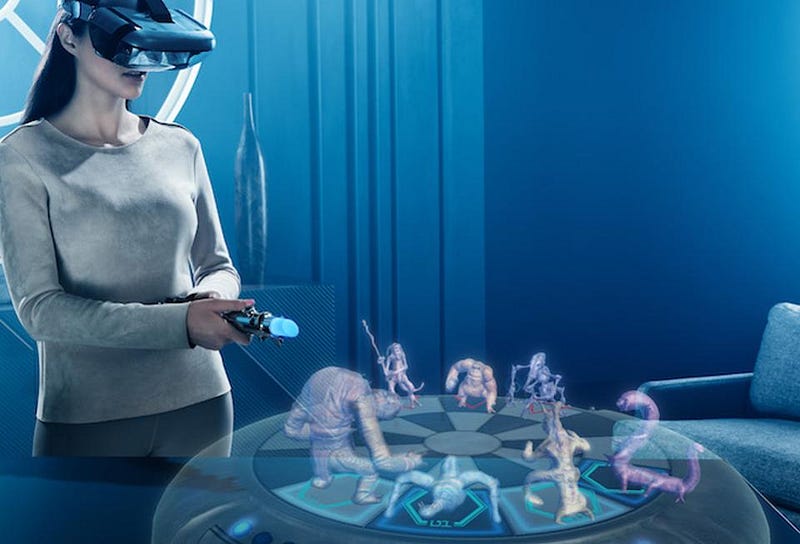
Although we’re focused here on AR and VR, we are offering legit advice for the holidays and new year, so we’d be remiss to leave out digital home assistants (home AI), Google Home ($49-$129) and Amazon Alexa ($49-$149). These are wonderful, low priced and useful (“Alexa, play news”; “Alexa, play Play Misty for Me”; “Google, how do I say ‘dog’ in German?”; “Google, turn out the lights”, etc.). If you’ve got a limited budget and a long list, a bag full of Google Home Minis or Alexa Echo Dots might make you very popular.
Thanks to Santa’s helpers Samuel Steinberger, Michael Eichenseer, and Samantha Wolfe for helping sort the bag below.

Star Wars Jedi Challenge AR $199
By combining AR, Star Wars, broadly appealing gameplay, an accessible $200 price, and exclusive distribution through Best Buy, Disney and Lenovo may just have the hit of the Christmas season. Slide your cell phone into the top of the plastic headset, fire up your lightsaber, and fight the stereoscopic enemies beamed onto the plastic visor of the headset that creates the illusion of ghostlike holograms in the real world. Jedi Challenge comes with three games: Lightsaber Battles, Strategic Combat, and Holochess. While progressing through the galaxy, players can achieve multiple Jedi mastery levels from Padawan to Knight and eventually Master. As you unlock the ranks of the Jedi Order, the lightsaber will change color. A must have for Star Wars fans, it’s possible with frequent updates that Star Wars AR could be with us for some time. — Charlie Fink
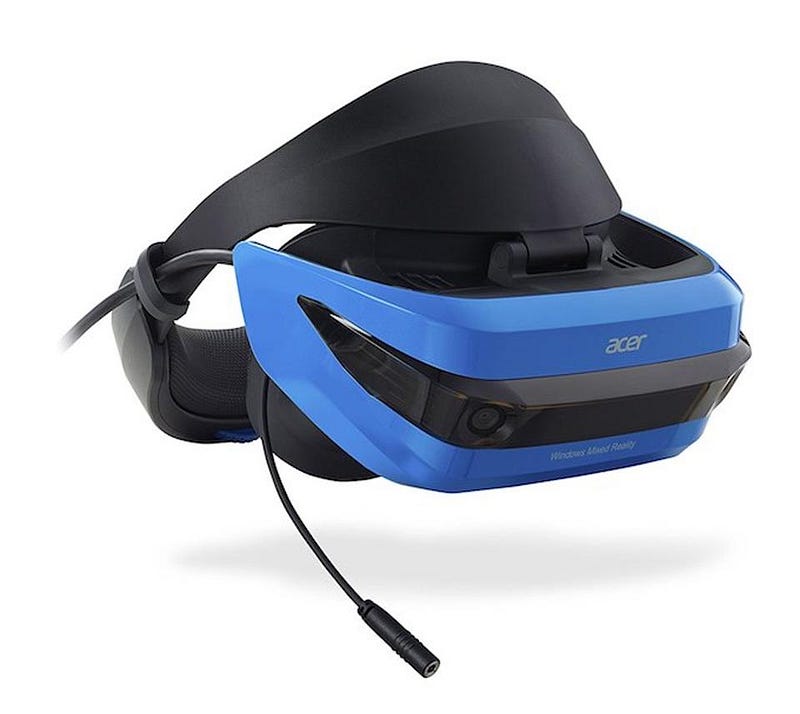
Windows MR with The New Acer HMD $399
Was it getting dark already? I’d just taken a five minute breather from playing Steam VR’s Paintball and realized I’d been playing for a solid four hours. I hadn’t eaten. I’d forgotten about doing my laundry. I’d completely lost track of time. My first experience with Acer’s Windows Mixed Reality headset was a smashing success.
But before I get into the details, let’s take a look at the device itself.
The Acer Windows Mixed Reality HMD is a thing of beauty. The blue and black visor is lightweight and comfortable, even over glasses. It’s an inside out HMD, which means the position of the visor is tracked by the visor itself, not by additional outside devices that need to be installed. It also means it’s the perfect size for my tiny New York City apartment living room, which is smaller than most bedrooms.
For my first foray into Windows MR, I’d invited my girlfriend and another friend over to check out the headset and provide a broader sample of the experience. When we first paired the controllers with the computer there was an audible “ooh” as they lit up. The controllers are responsive, although, after a few hours of action packed VR, I found my hands losing their grip at times and cramping up.
We followed the instructions on the screen to calibrate the set and fed the meager boundaries of my living room into the software. As the software launched, I was transported to an airy, spacious home on the side of a cliff overlooking fantastical floating islands with a backyard view of snow covered mountains. My home theater (I now had a home theater!) had a retractable roof. I could walk around my house, peg photos on the walls, and watch Penrose’s The Rose and I, a short VR movie.
While my friend and girlfriend took the same VR home walk around, I set up a Steam VR account. I’d heard about Rec Room’s Paintball game and wanted to give it a go. Little did I realize at the time that I was about to wave goodbye to all my afternoon plans.
https://www.youtube.com/watch?v=7Hm1drq-zm4
For the rest of the day, the three of us alternated playing VR paintball, watching VR movies, and exploring what Windows MR had to offer. I wasn’t disappointed, and my girlfriend said she was still seeing paintballs flying at her even after shutting down the HMD for the night , a sure sign of a good experience. If this isn’t the must have for the end of 2017, or beginning of 2018, I don’t know what is. It’s made me a VR believer, and judging by the number of newcomers flinging virtual paintballs at each other , I’m not alone. — Samuel Steinberger
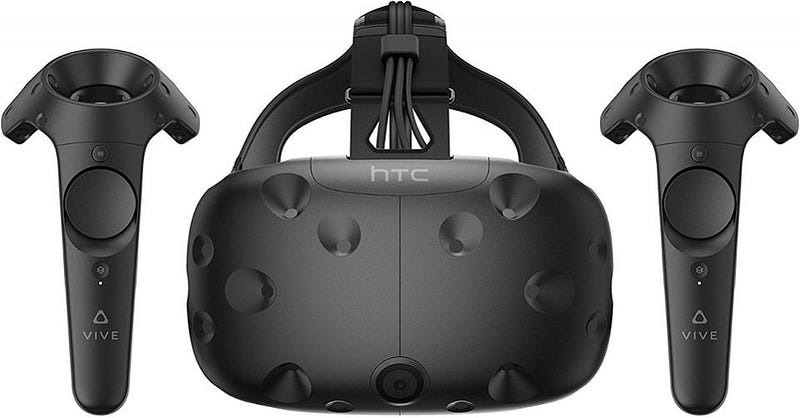
Oculus Rift ($399), HTC Vive ($599), Playstation VR ($299)
The Oculus, Vive, and PSVR are the premier gaming VR headsets on the market. Each headset has its benefits and limitations, and each one works best for certain occasions. If you’re interested in VR, you can’t go wrong with any of these three headsets. They’re all content rich, including experiences that are cross platform between all three.
The PSVR is an easy choice if your household already has a PS4 in the living room. This holiday season, a PS4 and PSVR bundle is $500 and is plug-and-play. Within minutes, your living room turns into a virtual world. However, PSVR is made for sitting or standing, not moving around. If you desire full room scale play, you’ll have to look into the PC-connected VR headsets.
The Oculus Rift has made waves with its precipitous price drops. Currently tagged at $399 for the headset and touch controllers and marked down to $350 for the holidays, the price makes the cost of a computer capable of running an Oculus Rift somewhat more palatable. There is an extra cost of $60 for a third camera if you want to play full room scale. After spending a thousand or more for a PC capable of running a Rift, you will be very impressed with the selection of exclusive games and high amount of cross platform play.
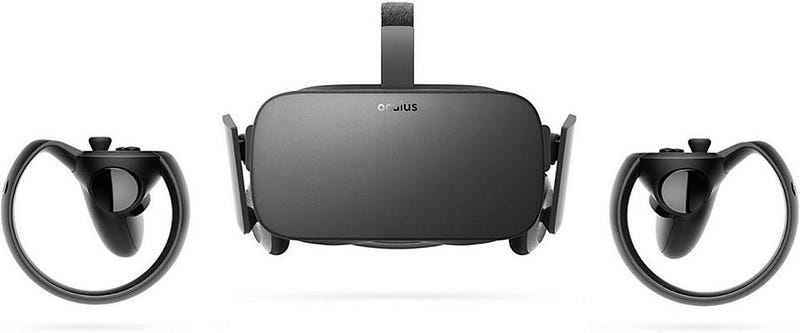
The HTC Vive offers a headset designed from the ground up for room scale with access to a massive library of Steam games. Whereas the Oculus needs a separate third camera in order to smoothly operate in room scale, the Vive does so with two lighthouses, both of which do not have to be connected via USB to the computer. Coming in at $599 alongside a VR-ready PC makes the Vive the most expensive of the bunch, though not much more than a room scale ready Oculus and Touch.

The PSVR may be the most successful of the VR headsets so far. The games are great too, with tons of PS4 exclusives. PSVR has one of the only AAA VR titles to date: Resident Evil 7, as well as Skyrim VR. A Skyrim VR PSVR bundle will be on sale this holiday season for $449, provided you already have a PS4. An Aim Controller in the shape of a two-handed gun comes bundled with Farpoint, a PSVR exclusive shooter, and will cost you an extra $80. Positive reviews for the bundle say it’s worth the cost.
There are quite a few free experiences for the Oculus that make the headset a bargain, as well as high quality exclusives developed through the Oculus developer program. One of the most popular multiplayer VR games, Echo Arena, is exclusive to the Oculus at this time, pitting teams of three players against each other in a zero gravity ultimate frisbee style arena.
The Vive has the largest selection of titles to play, many of which are small games built by indie developers. Most games for the Vive are cross platform with the Oculus, if not the PSVR, too, but that does not stop Vive exclusives from popping up. A prime example this holiday season is Fallout 4 VR.

Each of the three headsets are quite similar when it comes to visual quality. PSVR is the only system that is essentially plug-and-play. Both the Vive and Oculus require base stations and cameras to be set up around the play space and calibration to take place before a user can play.
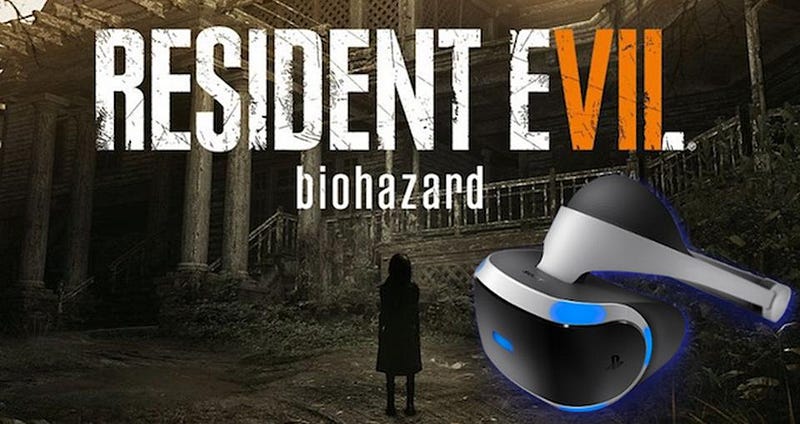
This holiday season, a PSVR headset, controllers, camera, and Skyrim VR game bundle will cost $449. A PS4 Slim will be priced at $199 alongside a bare-bones PSVR headset as low as $299. An Oculus Rift will be priced as low as $349, while a VR-ready PC will cost about $1000, and don’t forget the $60 for that third camera. The HTC Vive with Fallout 4 remains priced at $599.
Assuming you already have a high end gaming PC, it’s up to you to choose which headset you prefer. But if you have a PS4 at home, or, preferably, a PS4 Pro, then PSVR is the way to go. — Michael Eichenseer
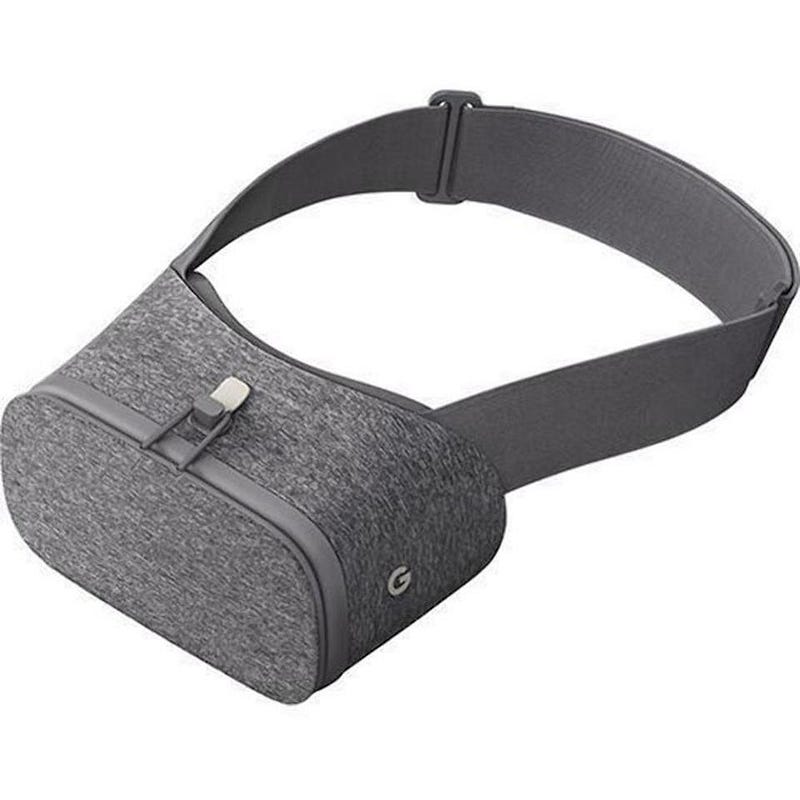
Google Daydream (Mobile VR) $69
Comfort and flexibility aren’t words you normally associate with VR. However, if you prioritize those qualities, Google’s $99 Daydream View is the mobile phone headset for you. The second generation 360-degree video mobile device has three choices of color fabric (charcoal, fog, and coral), a comfortable shape, and, as long as your phone is Daydream-compatible (such as the Pixel 2, Moto Z, Galaxy S8), you’re good to go. Like its cousin, Google Cardboard, you simply place your phone in the headset with no need to connect it electronically. However, if you must wear glasses with a headset, try the Daydream on before committing.
Although not official, analysts have estimated that there will be about 6.8 million Google Daydreams shipped this year. That’s pretty impressive for the new kid on the block. The Daydream headset uses Google Play (like other Android devices) and has about 200 apps (about half for free), up from 50 last year, with more on the way. The Daydream has some exclusive apps including Google’s Play Movies and YouTube. Although the Daydream isn’t technically “VR” like the higher end HTC Vive, the Daydream’s wireless remote controller is integrated into every game, allowing a certain amount of interactivity for driving a virtual car or wielding a sword. All this adds up to a comfortable headset that lets you get lost in a 360-degree world for hours at a time. — Samantha Wolfe
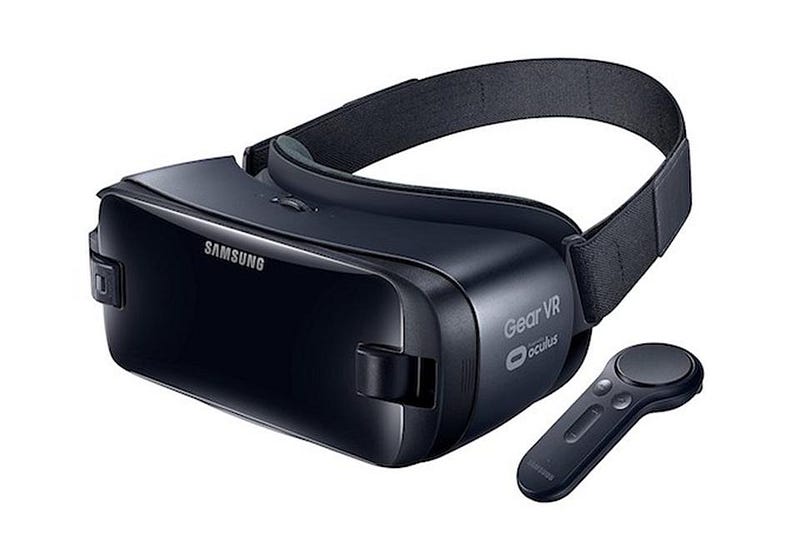
Samsung Gear VR $89
If you’re looking for a more substantial mobile phone-based headset with a deeper library of content, look no further than the $129 Samsung Gear VR (on sale for $89 and less). The 2017 Oculus-powered headset is lighter than last year’s version, has a wide 101-degree field-of-view, a wireless controller, padding that easily accommodates glasses, and a focus adjustment on top of the device. All of this adds up to a better feeling of immersion than other mobile headsets. This is why it’s sold over 8 million units, making it the most popular out there, besides the entry level Google Cardboard. Although it’s not true VR like the higher end Oculus Rift, the Samsung Gear VR still offers access to the rich library of games and experiences within the Oculus store. The set up is a bit awkward, but the content available is worth it. There’s well known TV and movie title offshoots like Stranger Things: Face Your Fears and Blade Runner 2049: Replicant Pursuit, as well as favorites such as Minecraft Gear VR Edition, Eve Gunjack, and Next VR for live sports and music in 360-degree view. Since Facebook bought Oculus, there is a push for more social games within the Oculus headsets, which you don’t find on the Daydream. As the Gear VR requires a Samsung Galaxy phone (S6 or later), if you have a Samsung phone or were considering getting one, this is the perfect headset choice. One exciting thing to note is that if you purchase the Samsung Galaxy S8 or the Galaxy Note8 Edition, it’s packaged with the Samsung Gear VR and compatible with the Google Daydream. — Samantha Wolfe
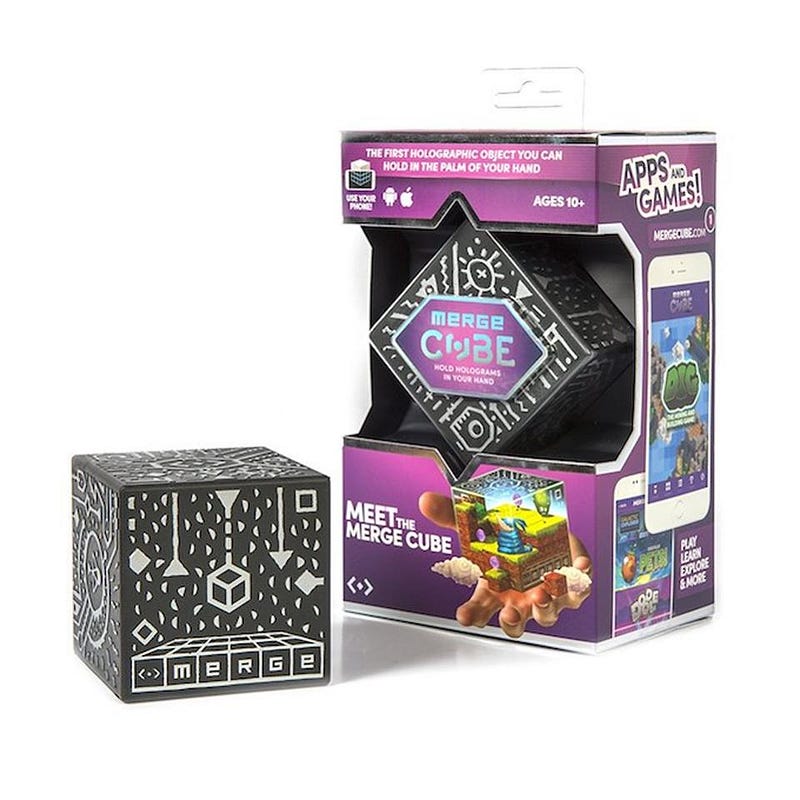
Merge Cube $14.99 and Merge AR/VR Goggles $47.99
The best thing about the Merge Cube is that it’s only $14.99, and it’ll keep your kids busy for hours, perhaps longer. At this price, it’s a can’t miss stocking stuffer.
The Merge Cube will work with older smartphones that cannot otherwise do AR, but it may cause them to run hot and drain batteries.
The award winning soft foam Merge Goggles are sold everywhere, and kids, in particular, love ’em. Works with the Merge Cube and any VR apps on the phone. A best seller. — Charlie Fink
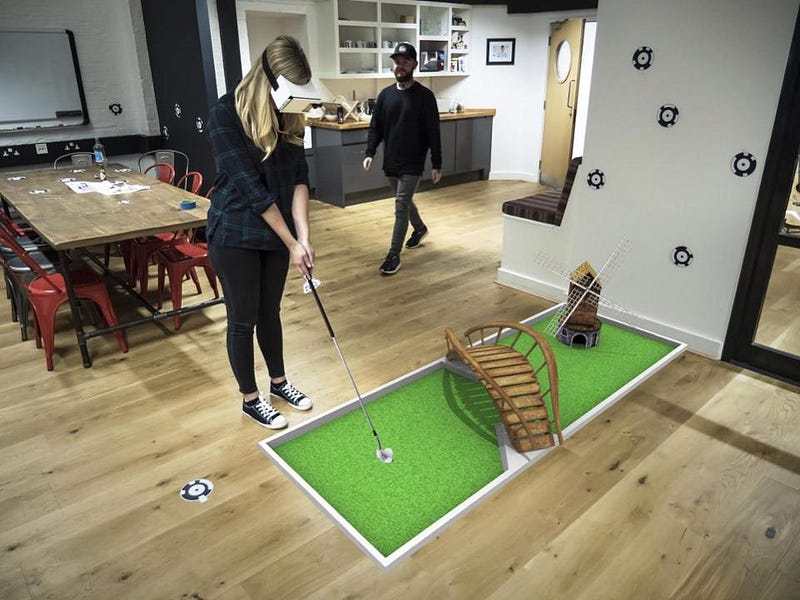
It’s possible that with the introduction of depth sensing cameras, AR kit maker Zappar may have had its moment. ZapBox makes “Magic Leap magic cheap” with its unique Cardboard HMD and controllers for your mobile phone.
This is some good, clean fun at a great price with a couple of dozen third party apps. — Charlie Fink
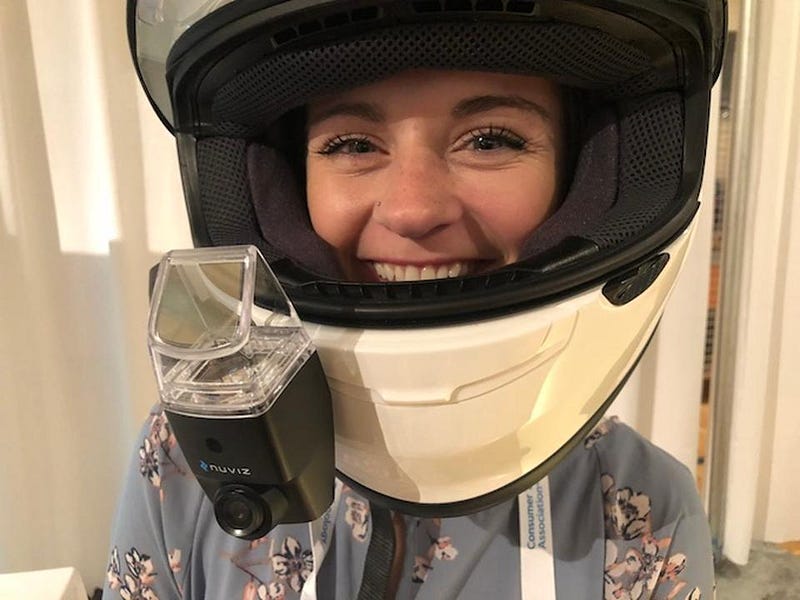
NUVIZ HUD for Motorcycles $699
Winner of a 2017 CES Innovation Award, NUVIZ is the first fully-integrated heads-up display (HUD) designed specifically for the needs of motorcycle riders. It displays customizable information in the rider’s natural line of sight and features an intuitive eyes-on-the-road handlebar controller and built-in HD action camera. NUVIZ brings together all the important functions of your navigation, communication, and media devices into a single device. I tried it. It’s really nice. Surprisingly so. — Charlie Fink
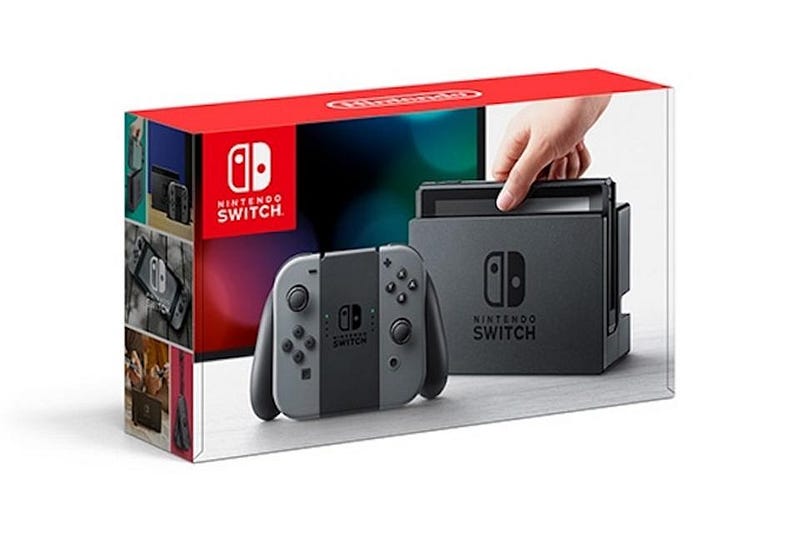
Nintendo Switch $299
Spoiler alert: there is an elephant in the room. I can smell it. It’s called the Nintendo Switch ($299). In case you haven’t seen it, it’s a new, super popular, handheld game console that may be the toy of the year. Superdata Research, one of the leading analysts of the $98.3 billion games business, thinks the Switch could rack up another 5.6 million in sales this Christmas , 14 million since its launch in March. It’s hard to see how Jedi Challenge or anything else will come even close.
The Switch features some of the most popular games in the world. I worry this is going to suck away a lot of dollars and attention we’d like to see in VR. The competition in the game arena is fierce. It’s almost twice as large as music and movies combined. Gamers are highly satisfied with their existing consoles and 2D games. The predicted rush to VR hasn’t happened yet. Let’s make a dent in that this year. — Charlie Fink
This post was originally featured on Forbes.com on November 22, 2017.


